#but like. I want to believe all the dead meeples are still out there to some degree okay 💔💔💔💔💔 okay 💔💔💔
Explore tagged Tumblr posts
Note
Hello again!! I’m gonna be sending in a lot of asks so sorry in advance :P
What happens to the Me-Products die exactly?? We know there is a Meeple Cloud but it’s a physical place unlike the ICloud?? Are the backed-up Meeple products INSIDE of the cloud hq is on???? Can they even be backed-up?? Adding to that where’s 4S now? Nothing else is inside 4’s “head”/MeLife since it’s now fully disabled, so WHERE IS BRO?! Is he all alone in that blue void? If so that is SO sad. Did he die or something? I HOPE not I love him a unreasonable amount (even I his generation infuriates me) someone genuinely help me with this please I BEG
.
#gaaah this is so interesting to think about ourhg#i’ve seen a lot of people come up with areas for ‘where meeplers go when they die’#in like fics and such but#I do actually wonder where they go in like. canon#a part of me wants to say there’s no afterlife for them because cobs wouldn’t care enough to give them any sort of afterlife#but like. I want to believe all the dead meeples are still out there to some degree okay 💔💔💔💔💔 okay 💔💔💔#ALSO I think?? brian was it??? confirmed thst 4s ISN’T alone up there#because everyone who didn’t run the red line game is just. stuck there now#so like. the unvitationals and some other side characters basically#thank you for the asks… I love reading these ouurhg#inanimate insanity#ii mephone4s#ii mephone4#ii meeple#meeple confession#the queue-ture is so yesterday
5 notes
·
View notes
Note
I wonder if the contestants would end up interacting with the real people outside of the places they already live.
That could become an issue when people start wondering what happened to Cobs and Meeple in general though, from what Cobs says it does sound like Meeple was going down a bit of a failure route since his products kept getting worse but he still seemed known enough so I feel like his sudden disappearance would raise some questions.
People might also be confused why inanimate insanity just kind of stopped, I'm pretty sure they didn't put most if any of the stuff we see on the finale on actual tv, I'm not sure how many people actually watch ii but they refer to the viewers in the context of the show when they vote in universe it probably has at least a bit of an audience.
I'm not sure if they would be on very good terms with the outside world especially if it becomes known that Cobs is dead and especially if it becomes known it was their fault, I'm not sure how many people would end up believing them when they try to explain why they killed Cobs in the first place.
Hello there!!^^ Welcome, and thank you for sending in an ask!!!! :)
His sudden disappearance would raise some questions, but the contestants could always lie. I mean if one of them said he exploded in a freak accident no one else would be barging in to tell the truth, yeah? No one wants Suitcase to go to jail, they're all happy that Cobs is dead, and it's probably for the best that they don't reveal the circumstances of their birth to the police or government or whoever finds them.
People probably would be confused!! I mean, all that the greater audience saw was Mephone's little intro at the beginning and Cobs' death battle before everything got wiped. Even if they don't have a huge audience in canon, there are definitely still people who are wondering what happened.
If it did become known that they were all responsible for Cobs' death, I think there would be mixed reactions. If all that he had done came out along with that, people would not be nearly as upset with them. People don't seem to like Cobs anyways, and with all the murder, kidnapping, and child abuse he committed, I doubt they'd miss him much. Without that, though, it would be much more controversial. Especially if the contestants refused to tell which one of them had actually committed the murder as a form of resistance.
#inanimate insanity#loomy's answers#inanimate insanity hc#loomy's metas#steve cobs ii#ii steve cobs#ii 18#ii finale#personally id be celebrating that a ceo died but thats just me
10 notes
·
View notes
Text
Board Games Wishlist (2021 Update)
So, I’ve been playing video games and there definitely will be a list highlighting some of them at the end of the year, but I haven’t been in touch with new releases and my attention shifted towards strategy games and city builders in particular. I spent quite a few hours on Crusader Kings 2 and Imperator: Rome too. Playing this kind of games got me closer to thinking about game design and narratives they present and slowly I moved back to watching reviews of board games and coming up with a prototype of my own, which I hopefully manage to transform into something to at least playtest later this year. If I get into that phase, I def will post pictures here. I’m still not that interested in playing board games myself, but I’m more interested in owning few now. So, my biggest concerns are graphic design and box sizes. Interesting mechanics or good flavour only come second. I’m making this list to showcase how my tastes developed over the last 2 years and to spotlight some newer designs, which influenced my own creativity. Out of roughly 30 games I find very intriguing, I decided to spotlight several in $100 challenge inspired by Board Game Barrage. I managed to include five smaller games, which I find to form a diverse starting collection. I used Game Nerdz for pricing, so It probably would cost slightly more locally. In addition to that this post includes a list of 10 other games I find myself attracted to for various reasons.
Pictures used in this article: 1) In the Hall of the Mountain King - Source: Burnt Island Games, 2) Fjords - Source: Board Game Geek, user Jacek Nowak, 3)Escape from the Aliens in Outer Space - Source: Board Game Geek, user Alessandro Fibbi
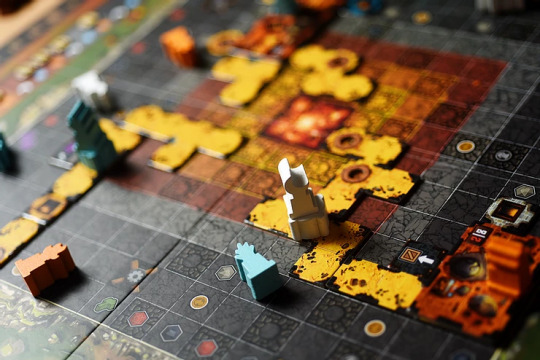
$100 Board Game Collection
I approached this challenge slightly differently than the BGB crew. My list doesn’t have a crunchy big game accompanied by several lighter games. All games on this list play fast and have a fairly easy set of rules. Two of these games are 2 players only and they’re all filled with tasty decisions and loads of strategy. The rest is a filler and a lighter pick up and delivery game from Reiner Knizia. Two of the games on the list aren’t properly out yet, but I believe they would fit my list perfectly.
1. Coup - I’m a fan of social deduction and hidden roles games and this one is a super easy one to pick up with nice illustrations and small packaging. I think games like this need a specific group of people, who are more into playing a game than usual social activities such as chatting or dancing, but It might be a good opener for silent groups with its high level of interaction, leading to a more interesting evening. Price at Nerdz: $11
2. Targi - Overall, I find worker placement games on the drier side. This one intrigues me because of how tight it is and before as a 2 player game, it offers more confrontation than competition. The new printing made it widely available at a very affordable price point. The small box and Berber theming are good too. Price at Nerdz: $14
3. Hive Pocket - This game is a classic and it could be easy to play it with people instead of chess. Hive consisting of sturdy tokens in a sack makes it a perfect companion for travels too. I find it that stranded far away from home, it’s way easier to have a good opportunity to play something as comforting as a board game. Price at Nerdz: $21
4. Whale Riders - An obligatory Reiner Knizia pick. It was a tough decision among several games, but I ultimately ended up siding with this pick up and delivery game, which even isn’t out yet. It puts interesting pressure on players, it plays in thirty minutes and looks awesome. The core mechanisms are something I wanted to have on this list yet. I heard that it is a tight design, maybe slightly less fulfilling than popular Knizia games, but given it’s playtime I wouldn’t worry too much about that. Price at Nerdz: $21
5. Fjords - The new edition of Fjords is currently being kickstarted and it looks gorgeous. It’s a very simple design, close to an abstract game. The first phase is tile laying, the second is go-like area control. I think this might be an excellent game to start playing very quickly and get invested into without complex mechanics obscuring possible strategies. The basic pledge on Kickstarter is $26 and It’s expected for the retail version to be more expensive (I would assume somewhere in the middle between estimated $40 and $26). The new version replaces tokens from the picture below with viking meeples and beautifies the tiles. Tbh, I find the look of the old version good with an exception of its box cover.
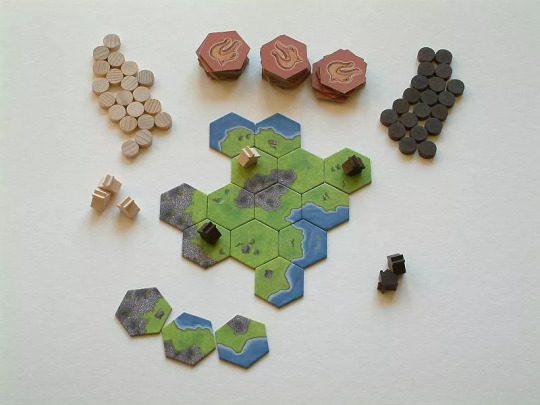
Osprey Games
This category stayed from the previous list. I still like fairly unified small boxes of theirs and their excellent design. They are all relatively small and fast playing. The themes aren’t as niche as some other games on this list and that should make it easier to play them with other players too. Finally, It should be fairly easy to order all four of them as a batch. Either from one of the local resellers or directly for slightly higher prices.
1. Cryptid - Cryptid is here for its sweet look and as a game I would find easy to show other people than gamers. It’s very abstract and I think that its components could be used to create your own games too. As a teacher I might use this in class to learn children about game design. Obviously, playing the deduction game might be a lot of fun and a good brain exercise too.
2. Escape from the Aliens in Outer Space - Again, this game has great graphic design and presents a different kind of experience. This is a hidden movement game, in which aliens and humans have asymmetric win conditions. The sparse presentation helps the game to build up a dense atmosphere. It’s very close to being more of a role playing game without a need to roleplay. I think I would enjoy this stressful experience a lot.
3. The King is Dead - is a simple area control game, which plays very quickly and by limiting players’ actions to an absolute minimum, makes every decision interesting. It’s a good vehicle for creating tension and players trying to influence each other into actions. The game has a dedicated community and you can find interesting homemade versions.
4. The Lost Expedition - and yet another fairly minimalist game with interesting mechanics and immersive look. In case of The Lost Expedition the game is at its best as a harsh solo survivor. You’re trying to get through the jungle and discover El Dorado. I love that it managed to capture the atmosphere of The Lost City of Z and despite its limited mechanics it looks like it succeeds at creating great emergent narratives and loads of friction.
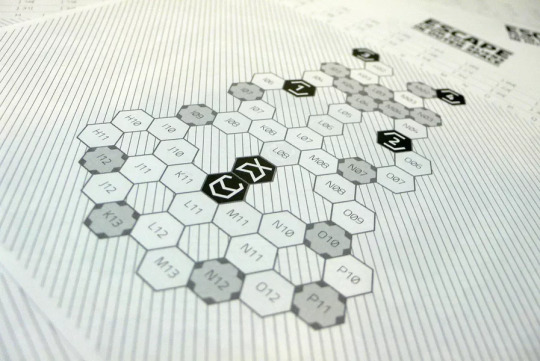
Other Games
These are various bigger games I find interesting. The reasons for me liking them differ quite a bit. In this category themes and mechanics are usually more of a reason for me to include them than presentation or size of boxes. All of them are too big anyway.
5. In the Hall of the Mountain King - This game is here for a special reason. I heard about it on Youtube, liked its board and theme, but also kinda disliked some of the mechanics. So, I started reading more about it, watched a playthrough and that led to me getting inspired and starting working on my own design, which takes a lot of inspiration from it. In the end, I still find the two main mechanics of the game slightly disconnected, scoring too complicated and spells unnecessary, but I also ended up liking the game a lot and I’m actually planning on buying it asap. The creators put a lot of love into it and the way you gather resources via a cascade of trolls looks like a great innovation. The parts I like the most happen on the board, tho. I find moving of statues and building of great halls very thematic and unfortunately kind of earthed by other mechanisms.
6. Coal Barons - After starting working on my design, I got more interested in mining games. There are only few interesting ones and alongside In the Hall of the Mountain King, Coal Barons from my favourites Kiesling and Kramer looks the best. It combines worker placement with action points and set collection in superbly thematic fashion. Mining different kinds of coal and loading them on trucks and trains feels like fun in this game. The other thing I love is that despite various actions you can take, the game is fairly tight and simple. Everything makes sense, rounds are fast and diverse scoring helps you to plan your next steps. I hope I’ll manage to find an older copy of this or that they’ll reprint it.
7. Tikal - Yes, It’s another Kiesling and Kramer and the first game of their Mask Trilogy. Mechanisms of this one also fueled by action points and actions you can take simple and confrontational. I like the theme and its table presence too. Unfortunately, getting hands on this one right now is fairly difficult, but there’s always hoping for a reprint of the Super Meeple edition of the game.
8. Akrotiri - is a two player game from the designer of In the Hall of the Mountain King. The game has two main components. The first one is exploration driven tile laying and the second is pickup and deliver mechanic. Basically, you compete as traders in this very stylized ancient sea. It feels like the game is very tight and that it offers enough paths to victory for good replay ability. I’m mostly interested in fairly simple rules and the game being faster than many other trading games with worse table presence. Together with Fjords, these two games feel like much better replacements for Carcassonne.
9. Yellow and Yangtze - I definitely wanted a second Reiner Knizia game on the list and after some consideration I decided to go with this one. Firstly, I like the cover and most of its components. Secondly, It would create a nice section of Grail Games in my library. That might be visually appealing too. I chose it over Tigris and Euphrates mostly for these two reasons as the older game seems to be preferred for its clarity by most Knizia fans. Still, It’s widely agreed that this is a great sequel full of confrontation and interesting choices.
10. The Great Zimbabwe - Splotter games are known for several things. They’re expansive, usually out of print and they have a specific esthetic. They’re also very highly regarded. The Great Zimbabwe is getting a reprint this year and after watching the video below I got super hooked in. It’s mechanics are deep, clever and among other games fairly unique. I also like the theme and thematic ties being present. I even like the look of the board and wooden components on it. If I had money to spare, I probably would pre-order it.
youtube
0 notes
Text
Only a Pawn in Their Game (Nippon)
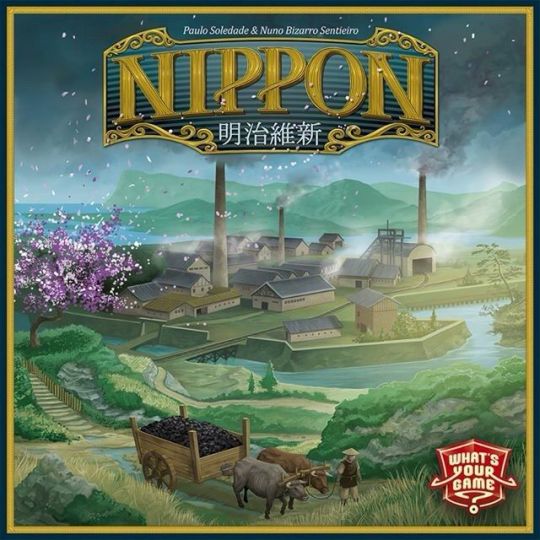
During an old video review published by the clever and astute duo of No Pun Included, Efka Bladukas said, quite deadpan, that “Nippon” was Japanese for “efficiency.” It was so deadpan–and I’m apparently enough of a philistine–that I believed it, no questions asked. You probably know that “Nippon” is actually is just a Japanese word meaning, ummm, “Japan.” It’s literal meaning is “the sun’s origin,” as in “the land of the rising sun.”
My naiveté aside, whatever the word for “efficiency” in Japanese is, that word would be a great name for Nippon, too!
Nippon (2015) Designed by Nuno Bizarro Sentieiro & Paulo Soledade Art by Mariano Iannelli Published by What’s Your Game?
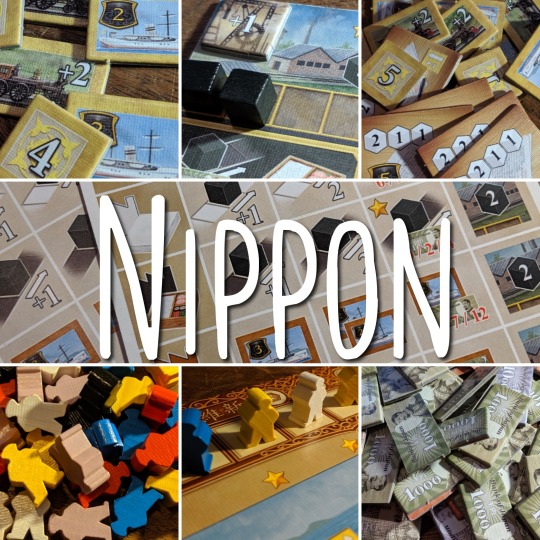
Its gorgeous cover aside, Nippon is one of the more stock-looking euro game–at first glance. Cubes, factories, a map with places for you to put markers of your color. Zzzzzzzzzzzzz... But wait! Not terribly unlike Village (2011), Nippon can almost hear what you’re thinking, but unlike Village–which added one mechanic to put a nice spin on a typical euro–Nippon subverts your expectations at every turn. Worker placement? Not really. Long term planning by saving your money? Hah! You simply cannot do that. Fulfilling orders/objectives for points? Not for points, brother.
Options are myriad, rounds are short, and no matter what you do, the game will be forcing you to pay through the nose every step of the way.
Lowdown (How to Play–in a Nutshell)
This game is fairly heavy, so rather than discuss actual actions or granular nuts and bolts of play, I’ll try and give you a broad overview and highlight some of the unique aspects of the game.
Nippon, by all accounts is a worker placement game, but not really. Those workers are the first thing you see when you first look at the board, but it’s all a ruse. At the top of the main map board are five columns, with all but one associated with two different action spaces (that fifth space is associated with only one big action space). Above each top action space, a random assortment of workers are sprinkled both during setup and in periodic refreshers throughout play. These workers are basic meeples of a variety of colors. On your turn you’ll take a meeple and add it to a track on your board, then you take one of the actions in the corresponding column. As you take more actions, maybe you’ll have a technicolor collection of workers on your track, or maybe you’ll be lucky enough to get duplicate colors (this is a good thing, by the way). Soon enough, you’ll be out of room on your track and you’ll need to take a consolidate action, instead, which will clear off your track, replenish your money and coal, and allow you to take more actions. The catch is that you have to pay your workers based on color. So if you have four workers of four different colors (eg red, blue, yellow, and white), you’ll be paying for a total of four workers. But if, instead, you have four workers of two different colors (eg two reds and two greens) you only have to pay for two workers. Duplicate colors are free!
Consolidating in Nippon is essentially that upkeep phase you have in many euro games. That being said, the game incentivizes you to wait longer before consolidating. The more workers you have on your track, the higher an end game scoring multipliers you’ll receive to place on your board, helping steer you towards some points at the game’s end. For example, if you have enough workers in your track, you will gain a x5 multiplier for you to put on an end game bonus space, like a space that signifying regions on the board. (This is hard to explain, but essentially in this example, once you get that x5 multiplier, it means you will gain 5 points for each region you’ve gotten one of your markers into by the end of the game; there are other spaces meaning things like “for every 6,000 Yen” or “for every advanced factory you’ve built,” etc)
Anyway, what are you doing with these workers? The point is to build factories, produce goods using coal, and then ship your goods oversees to fulfill orders for money and bonuses, or instead ship your goods locally across Japan to take a market share of an industry in a specific region. Each time you need to replenish meeples and there aren’t any meeples left, you’ll advance the turn marker one step forward. If you pass a scoring marker, you’ll score points for area control (or sometimes just presence) in each region on the map. The more goods you ship, the better your control is. After the third scoring round, you’ll add up all points, including from the end game multipliers you’ve been accumulating throughout the game, and the player with the most points wins.
Tea for Two (Scaling for Two Players)
Nippon is a reasonably fast game with two, but I’m not sure how fast it would be with three or four. The number of seeded meeples is different based on the player count. The first time we played, the game felt too short, but subsequent plays haven’t felt too short, but rather fast enough to drive you, but not so fast that you don’t have time to do things. Just fast enough to see the mistakes you make and wave at them as they fly by.
The other main scaling factor is that with two players only, there is a limit to the number of markers you can place in each city (two), meaning more often than not you’ll have one of each player’s color in each city. Each city will score points after each scoring phase is entered, giving points for first, second, and third place (the highest level marker you put out). But, to complicate things, each empty city space has a value in it, meaning that there is functionally a phantom player fighting for control of each city, too. Any uncovered number counts towards that phantom player’s control value, making it very difficult to get that coveted top points space in the area control scoring round. At most, you’ll probably get second behind the game itself.
All this is confusing to explain without really running through the rules, so I’ll just cut to it: this plays great with two.
Thorn Within (The Bad Stuff)
By all accounts, Nippon is a worker placement game (although Joel Eddy of Drive Thru Review Games described it beautifully as “worker displacement,” which is dead on), but all that worker juggling doesn’t actually score you any points. At first, you’d think the workers are really the main engine for those points, but they’re more like your utility tools in doing everything else. The points here are almost all in area control, not in production or any of the other basic action, and that’s deceptive. It’s all about the area control. Speaking of scoring via area control, if you find yourself running behind in the game, you are going to be hammered. And back to those workers, they really just stand in your way more often than not. Those workers are a money pit, because you have to pay 3,000 Yen for each difference color.
This can be really frustrating, because sometimes those meeple colors do not favor what you’re doing, and instead of picking four meeples and doing those for things you really need to do, you can’t because you can’t afford four different colored meeples. And slowly but surely, you have to sit and watch your opponent get their pieces on the board and score while you are stuck trying to scrape up money to catch up. There is a ton of stuff you can focus on in this game (upgrading machinery, building trains, building boats, upgrading coal production, fulfilling foreign orders, etc), and it’s easy to get lost down a rabbit hole that turns out to be, points-wise, a total dead end. But all of these aspects are interconnected, so you feel like you have to do everything. Nippon forces you to make tough decisions, and it often leaves you nothing but regrettable choices. You need to produce, but you don’t have enough coal; you want to up your coal production, but that won’t give you coal now, you need to ship locally to get a marker on the map, because if the next player takes that one meeple, it will trigger a scoring round and you’ll lose your shirt!
Not unlike Heaven & Ale (2017), Nippon is hard on the players. I wouldn’t call it brutal or unforgiving, but instead it feels like Nippon is a taskmaster. The game is demanding you to be an efficient manager, but it’s giving you no resources and no time to do it.
Carpe Diem Baby (The Good Stuff)
A lot of those bad things, well, they’re excellent. One of the more remarkable moments I’ve had in a game recently was a round of Nippon where I had a handful of actions I felt like I had to do, but I ended up abandoning my turn and consolidating early because I realized that I was better off not taking a new colored worker and spending 3,000 more Yen to pay for it. Here’s the thing about Nippon, when you consolidate, you lose all of your unspent money and coal. Yes, all of it. it is impossible to save your money turn-to-turn in hopes of paying for lots of workers in one turn and having that BIG TURN. That 2,000 Yen you didn’t spend this turn won’t roll over. Ditto next time. If you didn’t efficiently utilize your workers and money to maximize your turn, that’s tough on you. Remember, Nippon is Japanese for “efficiency” (it’s still not, by the way), so if you aren’t efficient, you are going to watch your money go up in smoke, along with your chances of winning.
Not having the ability to build up to your BIG TURN, Nippon forces you to grind your way through the game, slowly trying to out-think or out-maneuver your opponent. Should you fulfill overseas orders to increase your income level? That always feels like an excellent idea, because money is everything, and the more you have, the more you can do. At the same time, if you lean into fulfilling orders, the game will just slip away from you. Your carefully produced goods are hard to make, are you willing to pass up putting your markers on the map by fulfilling local orders just so you can make 2,000 more Yen each turn by fulfilling an overseas order? Cash will help you optimize your factories maybe, but what good will that cash be if you have no coal? What good will that cash be if you don’t have enough time to produce and ship? Cash converts to points, but it’s a bad conversion rate.
I can’t say enough about the gameplay of Nippon. This game is perfectly suited towards how I think, and the fact that it is essentially a game of nothing but tough decisions means it feels like it was designed for me. The worker displacement is puzzly, the rounds are fast and furious, and the game demands you to fight like hell to score those points. Love it.
The End (Final Thoughts)
Kathleen isn’t a huge fan of Nippon, but it’s a matter of preference. She agrees the game is remarkably well-designed, she just doesn’t like the demands it makes of the players, and I understand. Nippon forces you to diversify your actions, but ultimately all in service of the area control. If you aren’t able to manage that area control effectively, you will find this game very frustrating. Despite that respect for the design, it’s simply not suited to Kathleen’s play style.
At the end of the day, the good things and bad things are, for me, both good things. Everything I put into the “bad stuff” section ultimately equates to more tough decisions. I like that the game is a four course meal of which you can only eat one appetizer. Nippon presents you with a whole host of options, but gives you only the time and money to do 1/4 of what you’d like to do in a perfect world. Everything boils down to that time and money, and those are in such short supply here.
We played this game a bunch of times in the week or two after I got it, which got it into my top 10. It went dormant for a while. We pulled it out last week, and part of me was afraid it would have cooled a little. It didn’t. It climbed even higher in my top 10 list. It’s fantastic, and now it’s one of my favorite games.
This box is so crammed full of difficult choices, I can’t help but marvel at how difficult the decisions feel. For me, Nippon gets the highest marks. That being said, I fully understand it’s not for everyone. But if anything at all about this sounds interesting, get it. Get it now.

Player One Eric
#board games#board game#board game review#review#nippon#What's Your Game?#Nuno Bizarro Sentieiro#Paulo Soledade
1 note
·
View note